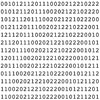- Eric Keto's Home Page
- High Mass Stars
- Starless Cores
- Extragalactic
- Radiative Transfer
- Hydrodynamics
- SMA Instrumentation
- IR Instrumentation
- MOLLIE radiative transfer
- Keto Prize
- Textbooks
|
The Mathematics of Instrument Design | ||||
|
Abstract Cross-correlation imaging interferometers designed in the shape of a curve of constant width offer better sensitivity and imaging characteristics than other designs because they sample the Fourier space of the image better than other shapes, for example, T's or Y's. In a cross-correlation interferometer each pair of antennas measures one Fourier component with a spatial wavenumber proportional to the separation of the pair. Placing the individual antennas of the interferometer along a curve of constant width, a curve that has the same diameter in all directions, guarantees that the spatial resolution of the instrument will be independent of direction because the measured Fourier components will have the same maximum spatial wavenumber in all directions. The most uniform sampling within this circular region in Fourier space will be created by the particular symmetric curve of constant width that has the lowest degree of rotational symmetry or fewest number of sides, which is the Reuleaux triangle. The constant width curve with the highest symmetry, the circle is the least satisfactory although still considerably better than T's or Y's. In all cases, the sampling can be further improved by perturbing the antenna locations slightly off a perfect curve to break down symmetries in the antenna pattern which cause symmetries and hence nonuniformities in the sampling pattern in Fourier space. Appropriate patterns of perturbations can be determined numerically. As a numerical problem, optimizing the sampling in Fourier space can be thought of as a generalization of the traveling salesman problem to a continuous two-dimensional space. Self-organizing neural networks which are effective in solving the traveling salesman problem are also effective in generating optimal interferometer shapes. The Smithsonian Astrophysical Observatory's Submillimeter Array, a cross-correlation imaging interferometer for astronomy, will be constructed with a design based on the Reuleaux triangle. Eric Keto, 1997, ApJ, 475, 843
Abstract Orthogonal sequences known as m-sequences can be used in place of Walsh functions in phase switching and sideband separation in cross-correlation interferometers. Functions based on three-character m-sequences may be advantageous because they may provide a larger set of mutually orthogonal modulation and demodulation functions, and hence support a larger number of antennas for a given sequence length, than allowed by other orthogonal sequences such as Walsh functions. The reason for this advantage is that if the demodulation functions are formed from the differences of the three-character m-sequence modulation functions, then because the m-sequences obey an addition rule whereby sums or differences of m-sequences are also m-sequences, the demodulation functions are also members of the original orthogonal set. In a complete set of sequences, all the differences are of course duplicates of the original sequences. However, certain subsets of sequences have differences which are not members of the subset, and these subsets can be used to form modulation and demodulation functions which have both the desired uniqueness and orthogonality properties. While it is not obvious how to select the subsets, heuristic methods seem reasonably successful. Eric Keto, 2000, PASP, 112, 711
| ||||
|
|


